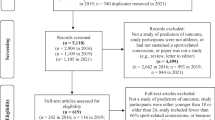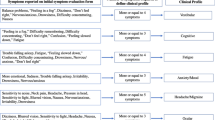Abstract
Background
Concussion literature and treatment guidelines are inconclusive regarding the role of sex in symptom reporting at baseline and post-concussion. Although empirical evidence is lacking, it is generally regarded that females have a more severe symptomatic presentation than males at all time-points on the concussion spectrum.
Objectives
Our objective was to determine whether differences exist between males and females at baseline (pre-season/before concussion) or post-concussion for self-reported (1) prevalence of individual symptoms and (2) total symptom scores in high school and college athletes.
Design
Systematic review and meta-analysis of observational cohort studies; level of evidence, 1.
Methods
A computerized search of the PubMed, SPORTDiscus, CINAHL, and Scopus databases was performed. Meta-analysis Of Observational Studies in Epidemiology (MOOSE) guidelines were followed. Criteria for inclusion were (1) self-report of symptoms at any time within the concussion spectrum, including baseline and after concussion, (2) study sample included high school and/or collegiate athletes aged 12–26 years, (3) concussions occurred during participation in sport, and (4) symptom reporting was separated by sex. The Quality Assessment Tool for Cohort Studies, Q-Coh, was utilized for quality assessment.
Results
Twenty-one studies met the criteria for inclusion: seventeen had good quality and four, acceptable quality. At baseline, females had significantly higher odds than males of reporting the individual symptoms of vision/hearing problems, headache/migraine, difficulty concentrating, energy/sleep disturbances, and emotional disturbances. Post-concussion, only one symptom demonstrated significant differences between males and females, with females demonstrating lower odds of reporting confusion than males. Statistically, at baseline and post-concussion, females had significantly higher total symptom scores on the Post-Concussion Scale (PCS) and the Sport Concussion Assessment Tool 2 (SCAT2), but when the standard mean difference was interpreted after back-transformation, these results were clinically insignificant.
Conclusions
The symptomatic presentation of males and females, most notably the prevalence of specific symptoms, is very divergent. Females had higher total symptom scores at baseline and post-concussion, however, clinically this cannot be interpreted as a meaningful difference. It is possible that these differences can be explained by normal hormonal changes associated with the menstrual cycle. The implications of these findings are that symptomatic presentation during an individual female’s menstrual cycle needs to be taken into consideration post-concussion when making return-to-play decisions, as returning to a completely asymptomatic level may not be a reasonable expectation.





Similar content being viewed by others

References
2013–2014 High school athletics participation survey. National Federation of State High School Associations; 2014.
Student-athletes. 2014. Available from: http://www.ncaa.org/student-athletes. Accessed 10 Nov 2014.
Langlois JA, Rutland-Brown W, Wald MM. The epidemiology and impact of traumatic brain injury. J Head Trauma Rehabil. 2006;21(5):375–8.
McCrory P. Consensus statement on concussion in sport: the 4th International Conference on Concussion in Sport held in Zurich, November 2012. Br J Sports Med. 2013;47:250–8.
Harmon KG, Drezner JA, Gammons M. American Medical Society for Sports Medicine position statement: concussion in sport. Br J Sports Med. 2013;47:15–26.
Broshek DK, Kaushik T, Freeman JR, et al. Sex differences in outcome following sports-related concussion. J Neurosurg. 2005;102(5):856–63.
Colvin AC, Mullen J, Lovell MR. The role of concussion history and gender in recovery from soccer-related concussion. Am J Sports Med. 2009;37:1699–704.
Covassin T, Swanik CB, Sachs ML, et al. Sex differences in baseline neuropsychological function and concussion symptoms of collegiate athletes. Br J Sports Med. 2006;40:923–7.
Covassin T, Swanik CB, Sachs ML. Sex differences and the incidence of concussions among collegiate athletes. J Athletic Training. 2003;38:238–44.
Lidvall HF, Linderoth B, Norlin B. Causes of the post-concussional syndrome. Acta Neurol Scand Suppl. 1974;56:3–144.
Preiss-Farzanegan SJ, Chapman B, Wong TM, et al. The relationship between gender and postconcussion symptoms after sport-related mild traumatic brain injury. PM R. 2009;1:245–53.
Rutherford WH. Sequelae of concussion caused by minor head injuries. Lancet. 1977;1:1–4.
Dick RW. Is there a gender difference in concussion incidence and outcomes? Br J Sports Med. 2009;43(Suppl 1):i46–50.
Kutcher JS, Eckner JT. At-risk populations in sports-related concussion. Curr Sports Med Rep. 2010;9:16–20.
Stroup DF, Berlin JA, Olkin I. Meta-analysis of observational studies in epidemiology: a proposal for reporting. JAMA. 2000;283(15):2008–12.
Huedo-Medina T, Sanchez-Meca J, Martin-Martinez F. Assessing heterogeneity in meta-analysis: Q statistic or I 2 index? The Center for Health, Intervention, and Prevention (CHIP): Digital Commons; 2006.
Higgins J, Thompson SG. Quantifying heterogeneity in a meta-analysis. Stat Med. 2002;21(11):1539–58.
McClure DJ, Zuckerman SL, Kutscher SJ. Baseline neurocognitive testing in sports-related concussions. Am J Sports Med. 2013;42(2):472–8.
Valovich McLeod TC, Bay RC, Lam KC, et al. Representative baseline values on the sport concussion assessment tool 2 (SCAT2) in adolescent athletes vary by gender, grade, and concussion history. Am J Sports Med. 2012;40(4):927–33.
Immediate Post-Concussion Assessment Testing (ImPACT) Test: technical manual. Online version 2007 to 2012: ImPACT Applications, Inc.; 2012.
Jarde A, Losilla JM, Vives J. Q-Coh: a tool to screen the methodological quality of cohort studies in systematic reviews and meta-analyses. Int J Clin Health Psychol. 2013;13(2):138–46.
Covassin T, Schatz P, Swanik CB. Sex differences in neuropsychological function and post-concussion symptoms of concussed collegiate athletes. J Neurosurg. 2007;61:345–51.
Covassin T, Elbin RJ, Harris W, et al. The role of age and sex in symptoms, neurocognitive performance, and postural stability in athletes after concussion. Am J Sports Med. 2012;40(6):1303–12.
Covassin T, Elbin RJ, Bleeker A, et al. Are there differences in neurocognitive function and symptoms between male and female soccer players after concussion? Am J Sports Med. 2013;41(12):2890–5.
Covassin T, Elbin RJ, Larson E, et al. Sex and age differences in depression and baseline sport-related concussion neurocognitive performance and symptoms. Clin J Sports Med. 2012;22(2):98–104.
Majerske CM, Mihalik JP, Ren D, et al. Concussion in sports: postconcussive activity levels, symptoms, and neurocognitive performance. J Athl Train. 2008;43(3):265–74.
Zuckerman S, Solomon GS, Forbes JA, et al. Response to acute concussive injury in soccer players: is gender a modifying factor? J Neurosurg Pediatr. 2012;10(6):504–10.
Brooks BL, Mrazik M, Barlow KM, et al. Absence of differences between males and female adolescents with prior sport concussion. J Head Trauma Rehabil. 2014;29(3):257–64.
Schneider KJ, Emery CA, Kang J, et al. Examining sport concussion assessment tool ratings for male and female youth hockey players with and without a history of concussion. Br J Sports Med. 2010;44:1112–7.
Mihalik JP, Register-Mihalik J, Kerr ZY, et al. Recovery of posttraumatic migraine characteristics in patients after mild traumatic brain injury. Am J Sports Med. 2013;41(7):1490–6.
Jinguji TM, Bompadre V, Harmon KG, et al. Sport Concussion Assessment Tool-2: baseline values for high school athletes. Br J Sports Med. 2012;46(5):365–70.
Schatz P, Neidzwski K, Moser RS, et al. Relationship between subjective test feedback provided by high-school athletes during computer-based assessment of baseline cognitive functioning and self-reported symptoms. Arch Clin Neuropsychol. 2010;25(4):285–92.
Kontos AP, Dolese A, Elbin RJ. Relationship of soccer heading to computerized neurocognitive performance and symptoms among female and male youth soccer players. Brain Inj. 2011;25(12):1234–41.
Shehata N, Wiley JP, Richea S, et al. Sport Concussion Assessment Tool: baseline values for varsity collision sport athletes. Br J Sports Med. 2009;43(10):730–4.
Kontos AP, Elbin RJ, Schatz P, et al. A revised factor structure for the Post-Concussion Symptom Scale: baseline and postconcussion factors. Am J Sports Med. 2012;40(10):2375–84.
Leach CA, Bay RC, Valovich McLeod TC. Baseline self-report symptoms and health-related quality of life in high school athletes: influence of sex and prior concussion history. Athletic Train Sports. Health Care. 2012;5(3):115–22.
Lovell MR, Iverson GL, Collins MW, et al. Measurement of symptoms following sports-related concussion: reliability and normative data for the post-concussion scale. Appl Neuropsychol. 2006;13(3):166–74.
Frommer LJ, Gurka KK, Cross KM, et al. Sex differences in concussion symptoms of high school athletes. J Athl Train. 2011;46(1):76–84.
Castile L, Collins CL, McIlvain NM, et al. The epidemiology of new versus recurrent sports concussions among high school athletes, 2005-2010. Br J Sports Med. 2012;46:603–10.
Schmelzer K, Ditzen B, Weisec C. Clinical profiles of premenstrual experiences among women having premenstrual syndrome (PMS): affective changes predominate and relate to social and occupational functioning. Health Care Women Int. 2014;00:1–20.
Freeman EW, Halberstadt SM, Rickels K. Core symptoms that discriminate premenstrual syndrome. J Women Health. 2011;20(1):29–35.
Ishii C, Kazuko Nishino L, Herrerias de Campos CA. Vestibular characterization in the menstrual cycle. Braz J Otorhinolaryngol. 2009;75(3):375–80.
Caras ML. Estrogenic modulation of auditory processing: a vertebrate comparison. Front Neuroendocrinol. 2013;34(4):285–99.
Bazarian JJ, Blyth B, Mookerjee S, et al. Sex differences in outcome after mild traumatic brain injury. J Neurotrauma. 2010;27:527–39.
Wunderle K, Hoeger KM, Wasserman S, et al. Menstrual phase as a predictor of outcome after mild traumatic brain injury in women. J Head Trauma Rehabil. 2013;29(5):E1–8.
Berz K, Divine J, Foss KB, et al. Sex-specific differences in the severity of symptoms and recovery rate following sports-related concussion in young athletes. Phys Sportsmed. 2013;41(2):58–63.
Acknowledgments
The authors of this paper would like to thank Jonathan Ford for his contributions in the identification of potential journal articles to be included in this review, and librarian, Shirley Lewis, for her assistance in the database search.
Compliance with ethical standards
None of the authors of this manuscript have a financial conflict of interest associated with this work. No funding was received in association with this project.
Author information
Authors and Affiliations
Corresponding author
Electronic supplementary material
Below is the link to the electronic supplementary material.
Rights and permissions
About this article
Cite this article
Brown, D.A., Elsass, J.A., Miller, A.J. et al. Differences in Symptom Reporting Between Males and Females at Baseline and After a Sports-Related Concussion: A Systematic Review and Meta-Analysis. Sports Med 45, 1027–1040 (2015). https://doi.org/10.1007/s40279-015-0335-6
Published:
Issue Date:
DOI: https://doi.org/10.1007/s40279-015-0335-6



